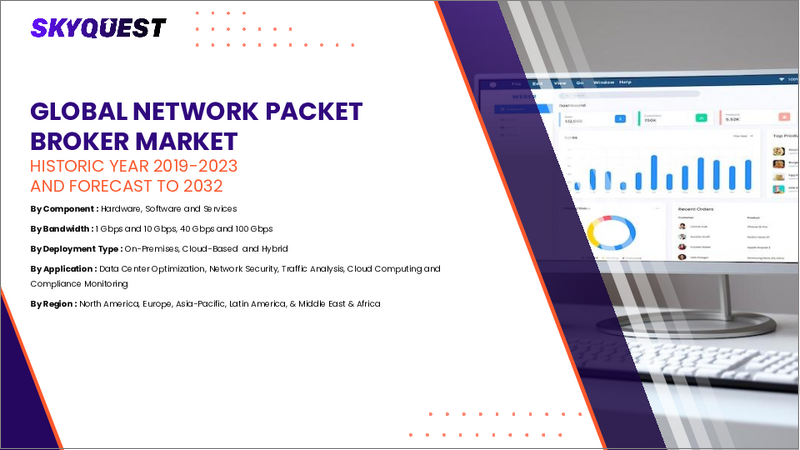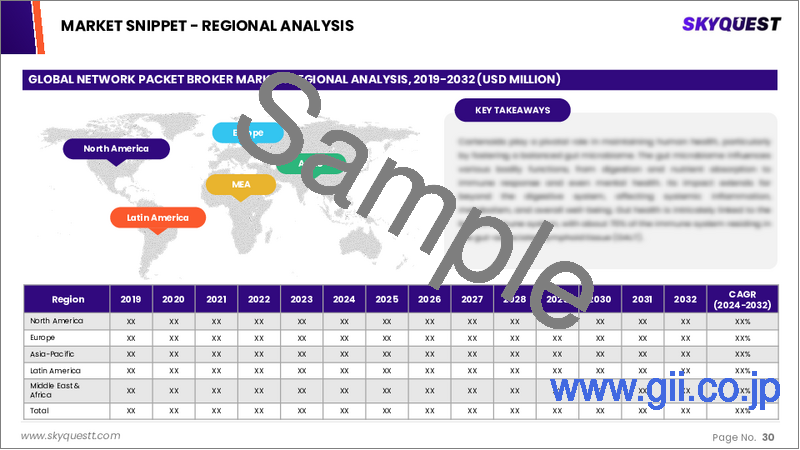|
|
市場調査レポート
商品コード
1656004
ネットワークパケットブローカーの市場規模、シェア、成長分析:コンポーネント別、展開モード別、用途別、エンドユーザー別、地域別 - 産業予測 2025~2032年Network Packet Broker Market Size, Share, and Growth Analysis, By Component (Hardware, Software), By Deployment Mode (On-Premises, Cloud-Based), By Application, By End-User, By Region - Industry Forecast 2025-2032 |
||||||
|
|||||||
| ネットワークパケットブローカーの市場規模、シェア、成長分析:コンポーネント別、展開モード別、用途別、エンドユーザー別、地域別 - 産業予測 2025~2032年 |
|
出版日: 2025年02月12日
発行: SkyQuest
ページ情報: 英文 157 Pages
納期: 3~5営業日
|
全表示
- 概要
- 目次
ネットワークパケットブローカー市場規模は2023年に9,110億米ドルとなり、2024年の9,729億5,000万米ドルから2032年には1兆6,468億7,000万米ドルに成長し、予測期間(2025年~2032年)のCAGRは6.8%で推移する見通しです。
ネットワークパケットブローカー(NPB)市場は、最新ネットワークの複雑化により大きな成長を遂げています。NPBは、トラフィックの分散、フィルタリング、転送を効率的に管理することで、ネットワークの監視とセキュリティを強化します。需要は、IT・通信、ヘルスケア、ITなどさまざまな分野に及んでおり、北米が最大の市場シェアを占め、欧州、アジア太平洋がこれに続いています。主な成長促進要因としては、クラウドコンピューティングの台頭、複雑なネットワーク構造、厳格なデータセキュリティ規制、IoTデバイスや5Gの普及などが挙げられます。しかし、高い資本コストや複雑な実装といった課題は依然として残っています。これらを克服するため、企業は拡張可能なNPBソリューションを進めており、複雑なネットワークフレームワークを保護することで市場が持続的に成長するよう位置付けています。
目次
イントロダクション
- 調査の目的
- 調査範囲
- 定義
調査手法
- 情報調達
- 二次と一次データの方法
- 市場規模予測
- 市場の前提条件と制限
エグゼクティブサマリー
- 世界市場の見通し
- 供給と需要の動向分析
- セグメント別機会分析
市場力学と見通し
- 市場概要
- 市場規模
- 市場力学
- 促進要因と機会
- 抑制要因と課題
- ポーターの分析
主な市場の考察
- 重要成功要因
- 競合の程度
- 主な投資機会
- 市場エコシステム
- 市場の魅力指数(2024年)
- PESTEL分析
- マクロ経済指標
- バリューチェーン分析
- 価格分析
- 規制情勢
- ケーススタディ
ネットワークパケットブローカー市場規模:コンポーネント別
- 市場概要
- ハードウェア
- ソフトウェア
- サービス
ネットワークパケットブローカー市場規模:展開モード別
- 市場概要
- オンプレミス
- クラウドベース
- ハイブリッド
ネットワークパケットブローカー市場規模:用途別
- 市場概要
- データセンターの最適化
- ネットワークセキュリティ
- トラフィック分析
- クラウドコンピューティング
- コンプライアンス監視
ネットワークパケットブローカー市場規模:エンドユーザー別
- 市場概要
- 通信
- ITおよびマネージドサービス
- ヘルスケア
- 政府
- BFSI
- その他
ネットワークパケットブローカー市場規模
- 北米
- 米国
- カナダ
- 欧州
- ドイツ
- スペイン
- フランス
- 英国
- イタリア
- その他欧州地域
- アジア太平洋地域
- 中国
- インド
- 日本
- 韓国
- その他アジア太平洋地域
- ラテンアメリカ
- ブラジル
- その他ラテンアメリカ地域
- 中東・アフリカ
- GCC諸国
- 南アフリカ
- その他中東・アフリカ
競合情報
- 上位5社の比較
- 主要企業の市場ポジショニング(2024年)
- 主な市場企業が採用した戦略
- 最近の市場動向
- 企業の市場シェア分析(2024年)
- 主要企業の企業プロファイル
- 企業の詳細
- 製品ポートフォリオ分析
- 企業のセグメント別シェア分析
- 収益の前年比比較(2022~2024年)
主要企業プロファイル
- Keysight Technologies, Inc.(USA)
- Gigamon(USA)
- Cisco Systems, Inc.(USA)
- Arista Networks, Inc.(USA)
- NetScout Systems, Inc.(USA)
- VIAVI Solutions Inc.(USA)
- APCON, Inc.(USA)
- Garland Technology(USA)
- Juniper Networks, Inc.(USA)
- Extreme Networks(USA)
- CPacket Networks(USA)
- Cubro Network Visibility(Austria)
- Network Critical(UK)
- Datacom Systems(USA)
- Profitap(Netherlands)
- CGS Tower Networks(Israel)
- Niagara Networks(USA)
- Microtel Innovation(Italy)
- Accton Technology Corporation(Taiwan)
- Big Switch Networks, Inc.(USA)
結論と提言
Network Packet Broker Market size was valued at USD 911.0 billion in 2023 and is poised to grow from USD 972.95 billion in 2024 to USD 1646.87 billion by 2032, growing at a CAGR of 6.8% during the forecast period (2025-2032).
The network packet broker (NPB) market is experiencing significant growth due to the increasing complexity of modern networks. NPBs enhance network monitoring and security by efficiently managing traffic distribution, filtering, and forwarding, crucial as organizations face larger data volumes and diverse applications. The demand spans various sectors, including telecommunications, finance, healthcare, and IT, with North America holding the largest market share, followed by Europe and Asia-Pacific. Key growth drivers include the rise of cloud computing, intricate network structures, stringent data security regulations, and the proliferation of IoT devices and 5G. However, challenges such as high capital costs and complex implementation persist. To overcome these, companies are advancing scalable NPB solutions, positioning the market for sustained growth in securing complex network frameworks.
Top-down and bottom-up approaches were used to estimate and validate the size of the Network Packet Broker market and to estimate the size of various other dependent submarkets. The research methodology used to estimate the market size includes the following details: The key players in the market were identified through secondary research, and their market shares in the respective regions were determined through primary and secondary research. This entire procedure includes the study of the annual and financial reports of the top market players and extensive interviews for key insights from industry leaders such as CEOs, VPs, directors, and marketing executives. All percentage shares split, and breakdowns were determined using secondary sources and verified through Primary sources. All possible parameters that affect the markets covered in this research study have been accounted for, viewed in extensive detail, verified through primary research, and analyzed to get the final quantitative and qualitative data.
Network Packet Broker Market Segments Analysis
Global Network Packet Broker Market is segmented by Component, Deployment Mode, Application, End-User and region. Based on Component, the market is segmented into Hardware, Software and Service. Based on Deployment Mode, the market is segmented into On-Premises, Cloud-Based and Hybrid. Based on Application, the market is segmented into Data Center Optimization, Network Security, Traffic Analysis, Cloud Computing and Compliance Monitoring. Based on End-User, the market is segmented into Telecommunications, IT and Managed Services, Healthcare, Government, BFSI and Others. Based on region, the market is segmented into North America, Europe, Asia Pacific, Latin America and Middle East & Africa.
Driver of the Network Packet Broker Market
The increasing prevalence of Internet of Things (IoT) devices, the widespread adoption of cloud computing, and the emergence of 5G networks have contributed to greater complexity in network environments. In this challenging landscape, network packet brokers play a crucial role by offering essential visibility and management capabilities. These tools help organizations effectively navigate and monitor their networks, ensuring optimal performance and security amidst the rising number of connected devices and advanced technology infrastructures. As a result, the demand for network packet brokers is expected to grow, making them an indispensable component for managing modern network complexities.
Restraints in the Network Packet Broker Market
The deployment and integration of network packet brokers can pose significant challenges for businesses, particularly when trying to align them with existing network architectures. Many organizations struggle with the complexities involved in achieving seamless integration and functionality, which can impede the effective use of these tools. This difficulty in incorporating network packet brokers into current systems serves as a restraint in the market, as companies must invest considerable effort and resources to ensure compatibility and optimal performance, ultimately hindering their operational efficiency and limiting the broader adoption of these critical technologies in their infrastructure.
Market Trends of the Network Packet Broker Market
The Network Packet Broker (NPB) market is experiencing significant growth fueled by the rising complexity of contemporary network architectures, largely propelled by the proliferation of IoT devices, the expansion of cloud computing, and the deployment of 5G technologies. Organizations are increasingly recognizing the necessity for sophisticated network monitoring and management solutions that can effectively navigate and optimize these intricate environments. NPBs play a crucial role in this landscape by offering enhanced visibility and control, allowing enterprises to ensure robust performance, security, and compliance across their networks. As these trends continue to evolve, the demand for NPB solutions is expected to accelerate further.
Table of Contents
Introduction
- Objectives of the Study
- Scope of the Report
- Definitions
Research Methodology
- Information Procurement
- Secondary & Primary Data Methods
- Market Size Estimation
- Market Assumptions & Limitations
Executive Summary
- Global Market Outlook
- Supply & Demand Trend Analysis
- Segmental Opportunity Analysis
Market Dynamics & Outlook
- Market Overview
- Market Size
- Market Dynamics
- Drivers & Opportunities
- Restraints & Challenges
- Porters Analysis
- Competitive rivalry
- Threat of substitute
- Bargaining power of buyers
- Threat of new entrants
- Bargaining power of suppliers
Key Market Insights
- Key Success Factors
- Degree of Competition
- Top Investment Pockets
- Market Ecosystem
- Market Attractiveness Index, 2024
- PESTEL Analysis
- Macro-Economic Indicators
- Value Chain Analysis
- Pricing Analysis
- Regulatory Landscape
- Case Studies
Global Network Packet Broker Market Size by Component & CAGR (2025-2032)
- Market Overview
- Hardware
- Software
- Service
Global Network Packet Broker Market Size by Deployment Mode & CAGR (2025-2032)
- Market Overview
- On-Premises
- Cloud-Based
- Hybrid
Global Network Packet Broker Market Size by Application & CAGR (2025-2032)
- Market Overview
- Data Center Optimization
- Network Security
- Traffic Analysis
- Cloud Computing
- Compliance Monitoring
Global Network Packet Broker Market Size by End-User & CAGR (2025-2032)
- Market Overview
- Telecommunications
- IT and Managed Services
- Healthcare
- Government
- BFSI
- Others
Global Network Packet Broker Market Size & CAGR (2025-2032)
- North America (Component, Deployment Mode, Application, End-User)
- US
- Canada
- Europe (Component, Deployment Mode, Application, End-User)
- Germany
- Spain
- France
- UK
- Italy
- Rest of Europe
- Asia Pacific (Component, Deployment Mode, Application, End-User)
- China
- India
- Japan
- South Korea
- Rest of Asia-Pacific
- Latin America (Component, Deployment Mode, Application, End-User)
- Brazil
- Rest of Latin America
- Middle East & Africa (Component, Deployment Mode, Application, End-User)
- GCC Countries
- South Africa
- Rest of Middle East & Africa
Competitive Intelligence
- Top 5 Player Comparison
- Market Positioning of Key Players, 2024
- Strategies Adopted by Key Market Players
- Recent Developments in the Market
- Company Market Share Analysis, 2024
- Company Profiles of All Key Players
- Company Details
- Product Portfolio Analysis
- Company's Segmental Share Analysis
- Revenue Y-O-Y Comparison (2022-2024)
Key Company Profiles
- Keysight Technologies, Inc. (USA)
- Company Overview
- Business Segment Overview
- Financial Updates
- Key Developments
- Gigamon (USA)
- Company Overview
- Business Segment Overview
- Financial Updates
- Key Developments
- Cisco Systems, Inc. (USA)
- Company Overview
- Business Segment Overview
- Financial Updates
- Key Developments
- Arista Networks, Inc. (USA)
- Company Overview
- Business Segment Overview
- Financial Updates
- Key Developments
- NetScout Systems, Inc. (USA)
- Company Overview
- Business Segment Overview
- Financial Updates
- Key Developments
- VIAVI Solutions Inc. (USA)
- Company Overview
- Business Segment Overview
- Financial Updates
- Key Developments
- APCON, Inc. (USA)
- Company Overview
- Business Segment Overview
- Financial Updates
- Key Developments
- Garland Technology (USA)
- Company Overview
- Business Segment Overview
- Financial Updates
- Key Developments
- Juniper Networks, Inc. (USA)
- Company Overview
- Business Segment Overview
- Financial Updates
- Key Developments
- Extreme Networks (USA)
- Company Overview
- Business Segment Overview
- Financial Updates
- Key Developments
- CPacket Networks (USA)
- Company Overview
- Business Segment Overview
- Financial Updates
- Key Developments
- Cubro Network Visibility (Austria)
- Company Overview
- Business Segment Overview
- Financial Updates
- Key Developments
- Network Critical (UK)
- Company Overview
- Business Segment Overview
- Financial Updates
- Key Developments
- Datacom Systems (USA)
- Company Overview
- Business Segment Overview
- Financial Updates
- Key Developments
- Profitap (Netherlands)
- Company Overview
- Business Segment Overview
- Financial Updates
- Key Developments
- CGS Tower Networks (Israel)
- Company Overview
- Business Segment Overview
- Financial Updates
- Key Developments
- Niagara Networks (USA)
- Company Overview
- Business Segment Overview
- Financial Updates
- Key Developments
- Microtel Innovation (Italy)
- Company Overview
- Business Segment Overview
- Financial Updates
- Key Developments
- Accton Technology Corporation (Taiwan)
- Company Overview
- Business Segment Overview
- Financial Updates
- Key Developments
- Big Switch Networks, Inc. (USA)
- Company Overview
- Business Segment Overview
- Financial Updates
- Key Developments





